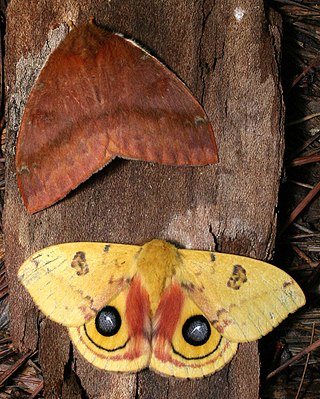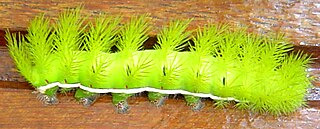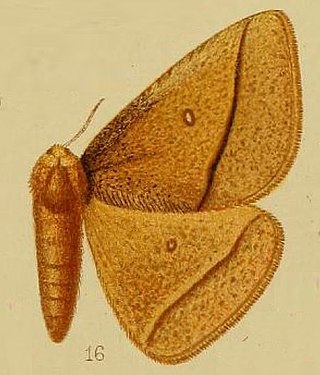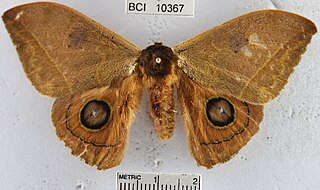
Saturniidae, members of which are commonly named the saturniids, is a family of Lepidoptera with an estimated 2,300 described species. The family contains some of the largest species of moths in the world. Notable members include the emperor moths, royal moths, and giant silk moths.

Oxytenis is a genus of moths in the family Saturniidae and subfamily Oxyteninae. They are also known as jigsaw emperor moths. he genus was erected by Jacob Hübner in 1819. During its larval form, it has large eyespots on the front of its head in an attempt to mimic a snake. The larva has unusual, large, almost wing-like, fleshy protrusions on either side.

Automeris io, the Io moth or peacock moth, is a colorful North American moth in the family Saturniidae. The Io moth is also a member of the subfamily Hemileucinae. The name Io comes from Greek mythology in which Io was a mortal lover of Zeus. The Io moth ranges from the southeast corner of Manitoba and in the southern extremes of Ontario, Quebec, New Brunswick and Nova Scotia in Canada, and in the US it is found from Montana, North Dakota, South Dakota, Nebraska, Colorado, New Mexico, Texas, Utah, east of those states and down to the southern end of Florida. The species was first described by Johan Christian Fabricius in 1775.

Antheraea godmani is a moth of the family Saturniidae first described by Herbert Druce in 1892. It is found from Mexico to Colombia.

Automeris illustris is a species of moth of the family Saturniidae first described by Francis Walker in 1855. It is found in South America, including Paraguay, Brazil and Argentina.

Automeris larra is a moth of the family Saturniidae. It is found in South America, including Brazil, French Guiana, Venezuela, Colombia, Peru, Bolivia and Ecuador.

Automeris is a genus of moths in the family Saturniidae and the subfamily Hemileucinae. As of 1996 there were 124 species, and more have since been described. These moths are generally characterized by the eyelike patches on the hindwings and the leaflike pattern on the forewings, an example of crypsis. The genus was first described by Jacob Hübner in 1819 and it is distributed in the Neotropical realm.

Decachorda is a genus of moths in the family Saturniidae. The genus was erected by Per Olof Christopher Aurivillius in 1898.

Automeris duchartrei is a moth of the family Saturniidae first described by Eugène Louis Bouvier in 1936. It is found in Ecuador, Bolivia and Peru.

Automeris belti is a moth of the family Saturniidae first described by Herbert Druce in 1886. A. belti is found from Mexico to Colombia and Ecuador. The wingspan is 95–100 mm.

Automeris postalbida is a moth of the family Saturniidae first described by William Schaus in 1900. It is found from Costa Rica to Ecuador.
Automeris celata is a moth of the family Saturniidae. It is found in the forests of tropical America, where it has been recorded from Mexico, Costa Rica, Panama and Colombia.
Automeris anikmeisterae is a moth of the family Saturniidae. It is found in Nicaragua and Costa Rica.

Caio championi is a large moth of the family Saturniidae first described by Druce in 1886. It is found from Mexico to Guatemala, south to western Ecuador and northern Venezuela.
Automeris randa, Rand's eyed silk moth, is a species of buck and io moths in the family Saturniidae. It was described by Herbert Druce in 1894 and is found in Central and North America.
Automeris louisiana, the Louisiana eyed silkmoth, is a species of moth in the family Saturniidae. It is found in North America.
Automeris zephyria, the zephyr eyed silkmoth, is a species of insect in the family Saturniidae. It is found in North America.
Automeris cecrops, the cecrops eyed silkmoth, is a species of insect in the family Saturniidae. It is found in Central America and North America.
Automeris patagoniensis, the Patagonia eyed silkmoth, is a species of insect in the family Saturniidae. It is found in North America.
Automeris iris, the iris eyed silkmoth, is a species of insect in the family Saturniidae. It is found in Central America and North America.











